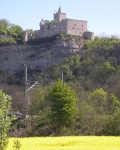Rudelsburg
Archaeology »
Archaeological Monuments » Rudelsburg
Rudelsburg - Germany
Rudelsburg is located in Burgenlandkreis,Saxony-Anhalt .
Rudelsburg monument was established on 18th century.
Primary threats to Rudelsburg :
The Rudelsburg was constructed in the middle Ages with a central keep divided into several sections and surrounded by an outer keep.
Historical facts of Rudelsburg :
- Rudelsburg is a historical fortress located in the Saale-Unstrut region of Saxony-Anhalt, Germany. With a rich and diverse history spanning over a thousand years, this castle has witnessed significant events, changes of power, and architectural transformations. Let's explore some of the historical facts about Rudelsburg.
- Early Origins : The earliest records of Rudelsburg date back to the 9th century when it was a simple wooden fortress constructed by the local noble family of the Thuringians. It served as a strategic defense post, guarding the trade routes along the Saale River.
- Rise of the Lords of Rudelsburg : Over the centuries, the Lords of Rudelsburg increased their influence and power in the region, becoming an important noble family. They expanded the castle and fortified its defenses, turning it into a formidable stronghold.
- Conflict and Sieges : Like many medieval castles, Rudelsburg experienced numerous sieges and conflicts. In the 12th and 13th centuries, it played a role in the ongoing struggles between the Holy Roman Empire and the Kingdom of Bohemia.
- The castle's history is interwoven with legends and folklore. One famous ballad, "Rudel's Lied," tells the tragic tale of the medieval troubadour and knight, Gottfried von Rudenberg (also known as Berthold von Rudelsburg), who fell in love with a distant princess he had never met. The ballad narrates his arduous journey and eventual death upon discovering his beloved's true identity.
- Renaissance Transformation : During the Renaissance period, the castle underwent significant architectural renovations, turning it into a residential palace rather than a military fortress. The Lords of Rudelsburg embraced the prevailing architectural styles of the time, adding elegant elements to the structure.
- Thirty Years' War : The Thirty Years' War (1618-1648) had a devastating impact on Rudelsburg. The castle changed hands multiple times between various factions, and it suffered severe damage during the conflict.
- Abandonment and Decay : In the aftermath of the Thirty Years' War, the castle gradually fell into disuse and decay. Its strategic importance waned, and it lost its role as a military stronghold.
- Rebuilding and Restoration : In the 19th century, the romantic fascination with medieval architecture sparked interest in restoring ancient castles. The Rudelsburg restoration began in the mid-1800s, aiming to preserve and revitalize the historic site.
- Modern-Day Attraction : Today, Rudelsburg stands as a popular tourist attraction, drawing visitors from around the world. Its stunning location atop a hill overlooking the Saale River and the surrounding vineyards adds to its allure.
- UNESCO World Heritage Site : Rudelsburg, along with the nearby Saale-Unstrut region, has been considered for inclusion in the UNESCO World Heritage List. The region's significant cultural and historical value, as well as its unique architectural heritage, make it a strong candidate for this prestigious recognition.
- In conclusion, Rudelsburg's historical significance spans from its humble beginnings as a wooden fortress to its transformation into a Renaissance palace and its eventual restoration as a beloved tourist attraction. With its connections to legends, conflicts, and architectural evolution, Rudelsburg remains a compelling site, showcasing Germany's rich and diverse history.

